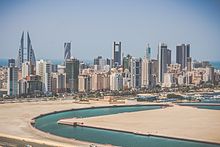
Back اقتصاد البحرين Arabic Economía de Baḥréin AST Bəhreyn iqtisadiyyatı Azerbaijani বাহরাইন#অর্থনীতি Bengali/Bangla Economia de Bahrain Catalan Wirtschaft Bahrains German Economía de Baréin Spanish اقتصاد بحرین Persian Économie de Bahreïn French Economía de Bahrain Galician
 Manama skyline | |
| Currency | Bahraini dinar (BHD) |
|---|---|
| Calendar Year | |
Trade organisations | WTO and GCC |
Country group | |
| Statistics | |
| Population | |
| GDP | |
| GDP rank | |
GDP growth |
|
GDP per capita | |
GDP per capita rank | |
GDP by sector |
|
| 0.075% (2023)[4] | |
Population below poverty line | N/A[6] |
Labour force | |
Labour force by occupation |
|
| Unemployment |
|
Main industries | Petroleum processing and refining, Aluminum Smelting, Iron Pelletization, Fertilizers, Islamic and Offshore Banking, Insurance, Ship Repairing, Tourism |
| External | |
| Exports | $27.635 billion (2018 est.) |
Export goods | Petroleum and Petroleum Products, Aluminum, Textiles, Gold |
Main export partners | |
| Imports | $23.399 billion (2018 est.) |
Import goods | Crude Oil, Machinery, Chemicals, Gold, Jewellery |
Main import partners | |
Gross external debt | $52.15 billion (2017 est.) |
| Public finances | |
| Revenues | $5.854 billion (2017 est.) |
| Expenses | $9.407 billion (2017 est.) |
| |
All values, unless otherwise stated, are in US dollars. | |
The economy of Bahrain is heavily dependent upon oil and gas.[14] The Bahraini Dinar is the second-highest-valued currency unit in the world.[15] Since the late 20th century, Bahrain has heavily invested in the banking and tourism sectors.[16] The country's capital, Manama is home to many large financial structures. Bahrain's finance industry is very successful. In 2008, Bahrain was named the world's fastest growing financial center by the City of London's Global Financial Centres Index.[17][18] Bahrain's banking and financial services sector, particularly Islamic banking, have benefited from the regional boom driven by demand for oil.[19] Petroleum is Bahrain's most exported product, accounting for 60% of export receipts, 70% of government revenues, and 11% of GDP.[20] Aluminium is the second most exported product, followed by finance and construction materials.[20]
According to the 2020 edition of the Index of Economic Freedom, published by The Heritage Foundation and The Wall Street Journal, Bahrain has the fourth-freest in the Middle East and North Africa region and is the 40th-freest economy in the world.[21] An alternative index, published by the Fraser Institute, puts Bahrain in 70th place.[22] Bahrain was recognised by the World Bank as a high income economy.[23]
- ^ "World Economic Outlook Database, April 2019". IMF.org. International Monetary Fund. Retrieved 29 September 2019.
- ^ "World Bank Country and Lending Groups". datahelpdesk.worldbank.org. World Bank. Retrieved 29 September 2019.
- ^ "Population, total - Bahrain". data.worldbank.org. World Bank. Retrieved 21 February 2020.
- ^ a b c d e f "World Economic Outlook Database, April 2024". IMF.org. International Monetary Fund. April 2024. Retrieved April 19, 2024.
- ^ a b c "MIDDLE EAST :: BAHRAIN". CIA.gov. Central Intelligence Agency. Retrieved 21 February 2020.
- ^ "The World Factbook". Retrieved 3 March 2015.
- ^ "Human Development Report 2023/2024" (PDF). United Nations Development Programme. 13 March 2024. Archived (PDF) from the original on 13 March 2024. Retrieved 15 June 2024.
- ^ "Labor force, total - Bahrain". data.worldbank.org. World Bank & ILO. Retrieved 21 February 2020.
- ^ "Employment to population ratio, 15+, total (%) (national estimate) - Bahrain". data.worldbank.org. World Bank & ILO. Retrieved 21 February 2020.
- ^ "World Bank Open Data". data.worldbank.org. Retrieved 14 November 2020.
- ^ "Export Partners of Bahrain". CIA World Factbook. 2016. Archived from the original on 2016-10-02. Retrieved 2018-03-09.
- ^ "Import Partners of Bahrain". CIA World Factbook. 2016. Archived from the original on 2016-08-13. Retrieved 2018-03-09.
- ^ "Sovereigns rating list". Standard & Poor's. Retrieved 26 May 2011.
- ^ "The World Factbook". Retrieved 29 October 2019.
- ^ "10 Most Expensive Currency In The World - Latest News Online, News, Fresh News, Online News". Archived from the original on 25 February 2015. Retrieved 3 March 2015.
- ^ "Bahrain's economy praised for diversity and sustainability". Bahrain Economic Development Board. Archived from the original on December 28, 2010. Retrieved 24 June 2012.
- ^ Hedge Funds Review 18 March 2008
- ^ Gulf Daily News 18 March 2008
- ^ "Bahrain calling – Banking & Finance". ArabianBusiness.com. 25 April 2008. Retrieved 27 June 2010.
- ^ a b "CIA World Factbook, "Bahrain"". Cia.gov. Retrieved 25 January 2011.
- ^ "Bahrain Economy: Population, GDP, Inflation, Business, Trade, FDI, Corruption". www.heritage.org. Retrieved 2020-09-18.
- ^ Gwartney, James; Lawson, Robert; Hall, Joshua; Murphy, Ryan; Berggren, Niclas; McMahon, Fred; Nilsson, Therese (2020). "Economic Freedom of the World Annual Report" (PDF). fraserinstitute.org.
- ^ "Bahrain | Data". data.worldbank.org. Retrieved 2020-09-18.